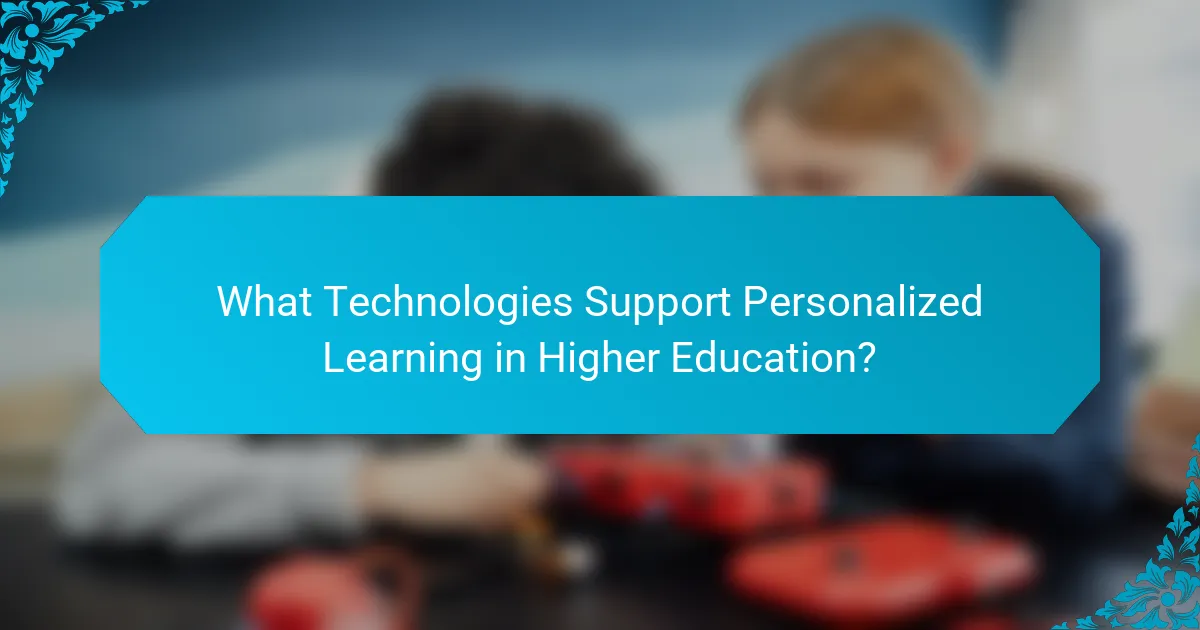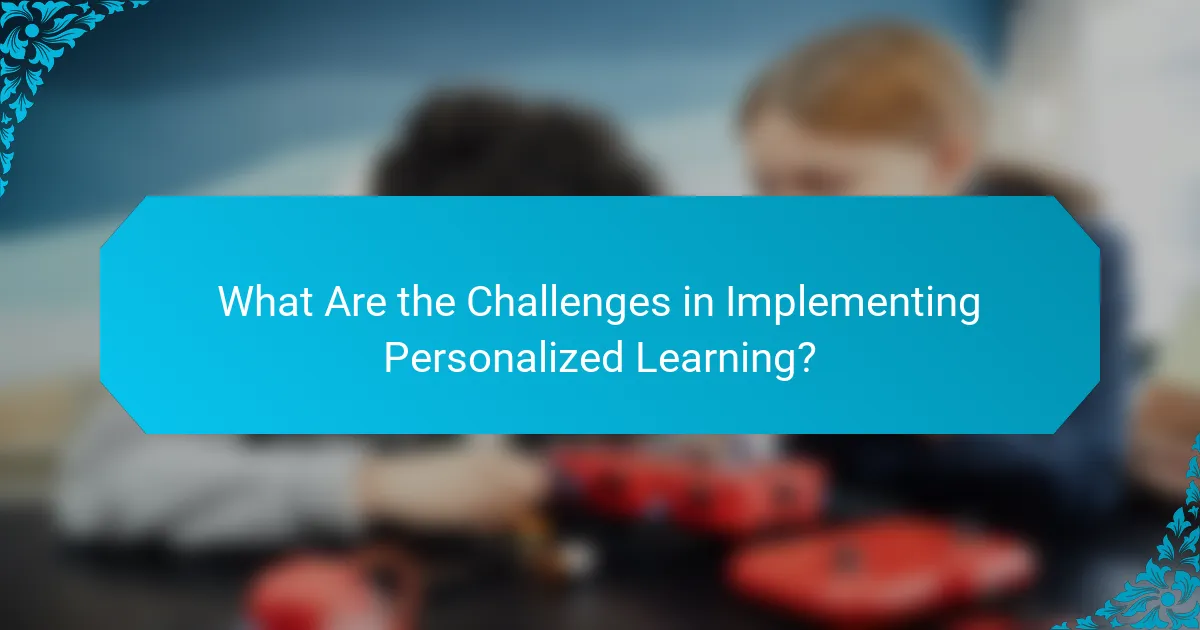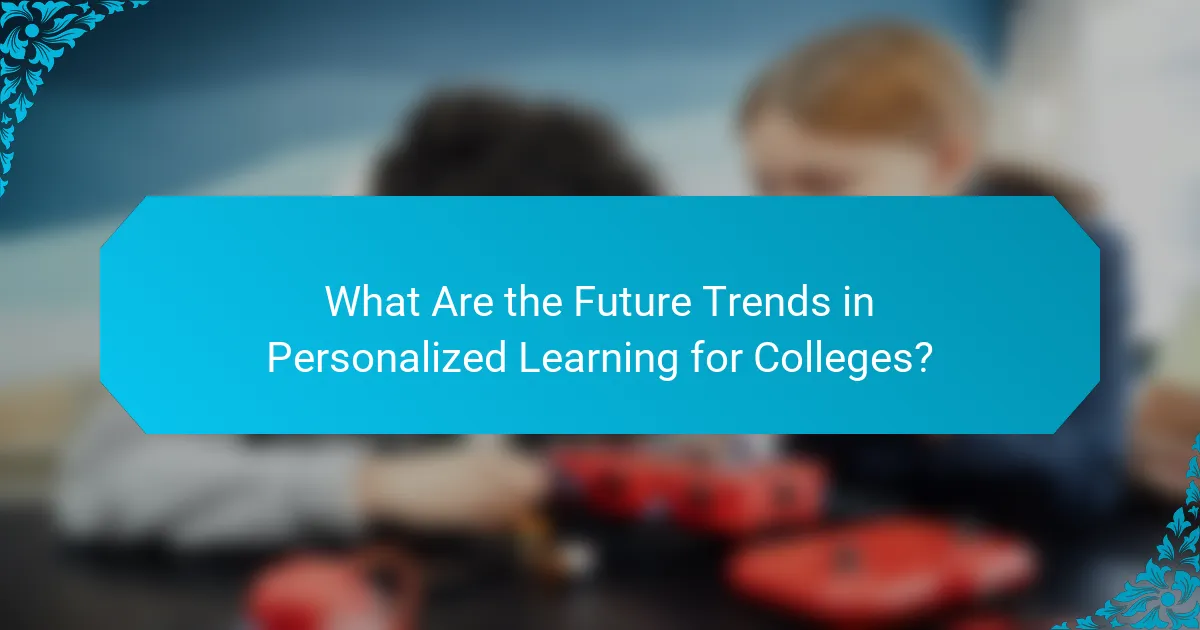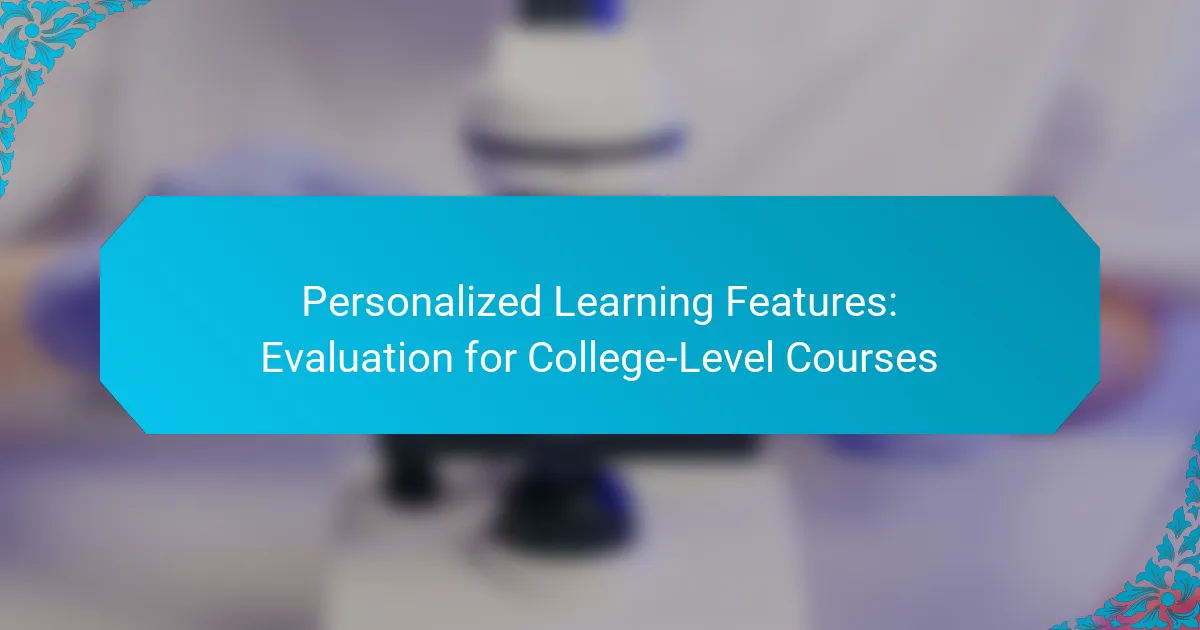Personalized learning features in college-level courses are designed to adapt to individual student needs, enhancing engagement and academic performance. By utilizing adaptive learning systems, learning analytics, and interactive content, these tools create customized educational experiences that cater to diverse learning styles. This approach not only improves retention rates but also fosters collaboration among students, ultimately leading to better educational outcomes.

What Are the Key Personalized Learning Features for College Courses?
Key personalized learning features for college courses include adaptive learning systems, learning analytics tools, interactive content delivery, personalized feedback mechanisms, and collaborative learning environments. These elements enhance the educational experience by tailoring learning paths to individual student needs and preferences.
Adaptive Learning Systems
Adaptive learning systems adjust the educational content and pace based on a student’s performance and engagement. They utilize algorithms to analyze responses and tailor the curriculum accordingly, ensuring that students receive the right level of challenge. For instance, if a student struggles with a particular concept, the system may offer additional resources or alternative explanations.
When implementing adaptive learning, consider the technology’s ability to integrate with existing course materials and its user-friendliness. Institutions should also ensure that faculty are trained to interpret data and adjust their teaching strategies based on insights from the system.
Learning Analytics Tools
Learning analytics tools collect and analyze data on student performance to provide insights into learning behaviors and outcomes. These tools can help educators identify at-risk students and tailor interventions to improve retention and success rates. For example, analytics might reveal that students frequently struggle with a specific module, prompting a review of the instructional approach.
To maximize the effectiveness of learning analytics, colleges should focus on data privacy and compliance with regulations like FERPA in the U.S. Institutions should also ensure that the analytics tools are user-friendly for both students and educators.
Interactive Content Delivery
Interactive content delivery involves using multimedia and engaging formats to present educational material, enhancing student engagement and retention. This can include videos, simulations, quizzes, and gamified elements that encourage active participation. For example, a biology course might use virtual labs to allow students to conduct experiments online.
When designing interactive content, ensure it aligns with learning objectives and is accessible to all students, including those with disabilities. Providing a mix of content types can cater to different learning styles and preferences.
Personalized Feedback Mechanisms
Personalized feedback mechanisms provide tailored responses to student submissions, helping them understand their strengths and areas for improvement. This can include automated feedback from assignments or personalized comments from instructors. For instance, an essay might receive specific suggestions for improvement based on the student’s writing style and content understanding.
To implement effective feedback mechanisms, educators should establish clear criteria for evaluation and ensure timely responses. Regular feedback can significantly enhance student motivation and learning outcomes.
Collaborative Learning Environments
Collaborative learning environments encourage students to work together on projects and assignments, fostering peer-to-peer learning. These settings can be enhanced through online platforms that facilitate discussion and resource sharing. For example, group projects in a digital workspace can allow students to collaborate regardless of their physical location.
When creating collaborative opportunities, consider the diversity of student backgrounds and learning styles to ensure inclusivity. Establishing clear roles and expectations within groups can also help improve the effectiveness of collaborative efforts.

How Do Personalized Learning Features Improve Student Outcomes?
Personalized learning features enhance student outcomes by tailoring educational experiences to individual needs, preferences, and learning styles. This approach fosters greater engagement, improves retention rates, and allows for customized learning paths that can significantly boost academic performance.
Enhanced Engagement
Personalized learning features increase student engagement by providing content that aligns with their interests and learning preferences. When students can choose topics that resonate with them or engage with interactive materials, they are more likely to participate actively in their education.
For example, adaptive learning technologies can adjust the difficulty of tasks based on a student’s performance, keeping them challenged but not overwhelmed. This tailored approach helps maintain motivation and encourages a deeper connection to the material.
Improved Retention Rates
Students who engage with personalized learning experiences often demonstrate improved retention rates. By focusing on individual learning styles and pacing, these features help reinforce knowledge through repetition and varied instructional methods.
Research indicates that students in personalized learning environments may retain information better than those in traditional settings. Techniques such as spaced repetition and immediate feedback can further enhance memory retention, leading to long-term academic success.
Tailored Learning Paths
Personalized learning allows for the creation of tailored learning paths that cater to each student’s unique journey. This means that students can progress at their own pace, moving quickly through familiar concepts while spending more time on challenging topics.
Institutions can implement learning management systems that track student progress and adapt coursework accordingly. This flexibility not only supports diverse learning needs but also empowers students to take ownership of their education, leading to higher satisfaction and achievement levels.

What Technologies Support Personalized Learning in Higher Education?
Personalized learning in higher education is supported by various technologies that adapt to individual student needs. Key tools include Learning Management Systems (LMS), artificial intelligence (AI) tutoring systems, and mobile applications, each offering unique features to enhance the learning experience.
LMS Platforms like Canvas
LMS platforms such as Canvas provide a centralized hub for course materials, assignments, and assessments, allowing for tailored learning experiences. Instructors can customize content delivery based on student performance and preferences, enabling a more personalized approach.
Features like analytics dashboards help educators track student engagement and progress, identifying those who may need additional support. Institutions should consider integrating LMS tools that offer flexibility in course design and user-friendly interfaces to enhance student interaction.
AI-Powered Tutoring Systems
AI-powered tutoring systems leverage machine learning algorithms to provide personalized assistance to students. These systems analyze individual learning patterns and offer customized resources, practice problems, and feedback based on performance.
For example, platforms like Carnegie Learning adapt their content in real-time, ensuring that students receive help precisely when they need it. When selecting an AI tutoring system, institutions should evaluate the system’s ability to integrate with existing technologies and its effectiveness in improving student outcomes.
Mobile Learning Applications
Mobile learning applications facilitate personalized learning by allowing students to access educational content anytime and anywhere. These apps often include features like quizzes, flashcards, and interactive lessons that adapt to the user’s learning pace and style.
For instance, apps like Duolingo use gamification to engage users while providing personalized language learning experiences. When implementing mobile learning solutions, institutions should ensure that the applications are compatible with various devices and consider student preferences for mobile learning formats.

How to Evaluate Personalized Learning Features for College Courses?
Evaluating personalized learning features for college courses involves assessing their effectiveness in meeting diverse student needs and enhancing learning outcomes. Key factors include the criteria for assessment, gathering stakeholder feedback, and benchmarking against established standards.
Criteria for Assessment
When assessing personalized learning features, consider criteria such as adaptability, engagement, and learning outcomes. Features should be able to adjust to individual learning styles and paces, ensuring that all students can progress effectively.
Additionally, evaluate the usability of the platform, including how intuitive it is for both students and instructors. A user-friendly interface can significantly impact the adoption and effectiveness of personalized learning tools.
Stakeholder Feedback
Gathering feedback from stakeholders, including students, instructors, and administrators, is crucial for evaluating personalized learning features. Conduct surveys or focus groups to understand their experiences and perceptions of the tools being used.
Pay attention to common themes in the feedback, such as ease of use, perceived effectiveness, and areas for improvement. This information can guide future enhancements and ensure that the features align with user needs.
Benchmarking Against Standards
Benchmarking personalized learning features against recognized educational standards helps ensure quality and effectiveness. Look for alignment with frameworks such as the Quality Matters (QM) standards or the International Society for Technology in Education (ISTE) standards.
Establishing benchmarks allows institutions to compare their personalized learning offerings with those of other colleges or universities. This can highlight strengths and weaknesses, guiding improvements and ensuring that the features meet educational goals.

What Are the Challenges in Implementing Personalized Learning?
Implementing personalized learning in college-level courses presents several challenges, including resource allocation, faculty training, and data privacy concerns. Addressing these issues is crucial for successful integration and effectiveness of personalized learning approaches.
Resource Allocation Issues
Resource allocation is a significant challenge in personalized learning, as it often requires additional funding and materials. Institutions may need to invest in technology, software, and learning resources tailored to individual student needs, which can strain budgets.
For example, colleges might need to purchase adaptive learning platforms or hire specialized staff to support personalized learning initiatives. This can lead to competition for limited financial resources, making it essential to prioritize investments that yield the best educational outcomes.
Faculty Training Requirements
Effective implementation of personalized learning necessitates comprehensive faculty training. Instructors must be equipped with the skills to utilize new technologies and adapt their teaching methods to accommodate diverse learning styles.
Training programs should focus on practical applications, such as integrating technology into lesson plans and assessing student progress. Institutions may consider ongoing professional development opportunities to ensure faculty remain updated on best practices and innovations in personalized learning.
Data Privacy Concerns
Data privacy is a critical concern when implementing personalized learning, as it involves collecting and analyzing student data. Institutions must navigate regulations such as FERPA in the U.S. or GDPR in Europe to protect student information while still leveraging data for personalized instruction.
Colleges should establish clear policies regarding data collection, usage, and storage, ensuring transparency with students. It is vital to implement robust security measures to safeguard sensitive information and maintain student trust in the personalized learning process.

What Are the Future Trends in Personalized Learning for Colleges?
Future trends in personalized learning for colleges focus on leveraging technology to tailor educational experiences to individual student needs. This approach enhances engagement and improves learning outcomes by utilizing data-driven insights to inform instructional strategies.
Integration of AI and Machine Learning
The integration of AI and machine learning into personalized learning systems allows for real-time data analysis and adaptive learning pathways. These technologies can assess student performance and preferences, adjusting content delivery to optimize learning experiences.
For example, AI algorithms can recommend specific resources or study plans based on a student’s strengths and weaknesses. This tailored approach can significantly improve retention rates and overall academic success, making it a valuable tool for colleges aiming to enhance their educational offerings.
Colleges should consider investing in AI-driven platforms that provide analytics on student engagement and progress. However, it is crucial to ensure data privacy and compliance with regulations like FERPA in the U.S. when implementing these technologies.
